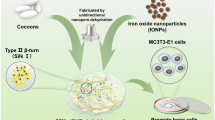Abstract
Three-dimensional bioprinting enables the generation of precisely controlled 3D cell models and tissue constructs by engineering anatomically shaped substrates with tissue-like complexity. Due to the high degree of control on structure and composition, 3D bioprinting has the potential to satisfy many critical needs in medical applications, including applications in cosmetics testing, regenerative medicine, and functional organ replacement. In this study, a series of new crosslinked polymeric porous bioinspired composite membranes containing decellularized elastic cartilage scaffold(dECS) would be designed and prepared from porcine elastic cartilage by using supercritical carbon dioxide fluid for 3D bioink and 3D bioprinting materials. Effect of crosslinking functionality on microstructures and thermal properties of new polymeric porous bioinspired composite membranes containing dECS would be further studied. This work would provide a simple and time-saving method process for the preparation of polymeric porous composite membranes containing dECS, which were further characterized by Fourier transform infrared spectroscopy, thermal properties, morphology, mechanical properties, and hemocompatibility.






Similar content being viewed by others
References
Mandrycky C, Wang Z, Kim K, Kim DH (2016) 3D bioprinting for engineering complex tissues. Biotechnil Adv 34:422–423
Malda J (2013) 25th anniversary article: engineering hydrogels for biofabrication. Adv Mater 25:5011–5028
Skardal A, Atala A (2015) Biomaterials for integration with 3-D bioprinting. Ann Biomed Eng 43:730–746
Yao R, Zhang R, Luan J, Lin F (2012) Alginate and alginate/gelatin microspheres for human adipose-derived stem cell encapsulation and diferentiation. Biofabrication. 4:025007
Jiang T, Munguia-Lopez JG, Flores-Torres S, Grant J, Vijayakumar S, Leon-Rodriguez AD, Kinsella JM (2017) Directing the self-assembly of tumor spheroids by bioprinting cellular heterogeneous models within Alginate/Gelatin hydrogels. Sci Rep 7:4575
Liaw DJ, Huang CC, Sang HC, Kang ET (1999) Intramolecular hydrophobic aggregation of amphiphilic polysulfobetaine with various hydrophobic groups in aqueous solution. Langmuir 15:5204–5211
Liaw DJ, Chen TP, Huang CC (2005) Self-assembly aggregation of highly stable copolynorbornenes with amphiphilic architecture via ring-opening metathesis polymerization. Macromolecules 38:3533–3538
Zhai G, Toh SC, Tan WL, Kang ET, Neoh KG, Huang CC, Liaw DJ (2003) Poly(vinylidene fluoride) with grafted zwitterionic polymer side chains for electrolyte-responsive microfiltration membranes. Langmuir 19:7030–7037
Liaw DJ, Huang CC, Lee WF, Borbély J, Kang ET (1997) Synthesis and characteristics of the poly(carboxybetaine)s and the corresponding cationic polymers. J Polym Sci Part A Polym Chem 35:3527–3536
Li ZF, Kang ET, Neoh KG, Tan KL, Huang CC, Liaw DJ (1997) Surface Structures and adhesive-free adhesion characteristics of polyaniline films after modification by graft copolymerization. Macromolecules 30:3354–3362
Zhai G, Toh SC, Tan WL, Kang ET, Neoh KG, Huang CC, Liaw DJ (2003) Poly(vinylidene fluoride) with grafted zwitterionic polymer side chains for electrolyte-responsive microfiltration membranes. Langmuir 19(2003):7030–7037
Smidsrød O, Skjak-Braek G (1990) Alginate as immobilization matrix for cells. Trends Biotechnol 8:71–78
Liu YW, Huang CC, Wang YY, Xu J, Wang GD, Bai XP (2021) Biological evaluations of decellularized extracellular matrix collagen microparticles prepared based on plant enzymes and aqueous two-phase method, Regenerative. Biomaterials 8:1–10
Wu J, Kong T, Yeung KW (2013) Fabrication and characterization of monodisperse PLGA-alginate core-shell microspheres with monodisperse size and homogeneous shells for controlled drug release. Acta Biomater 9:7410–7419
Lee KY, Mooney DJ (2012) Alginate: properties and biomedical applications. Prog Polym Sci 37:106–126
Anal AK, Stevens WF (2005) Chitosan-alginate multilayer beads for controlled release of ampicillin. Int J Pharm 290:45–54
Huang CC, Liu CY, Huang CY, Liu HW (2014) Carbodiimide crosslinked and biodegradation-controllable small intestinal submucosa sheets. J Bio-Med Mater Eng 24(6):1959–1967
Camacho NP, West P, Torzilli PA, Mendelsohn R (2001) FTIR microscopic imaging of collagen and proteoglycan in bovine cartilage. Biopolymers 62:1–8
Vogel KG, Trotter JA (1987) The effect of proteoglycans on the morphology of collagen fibrils formed in vitro. Coll Relat Res 7:105–114
Theocharis AD, Skandalis SS, Gialeli C, Karamanos NK (2016) Extracellular matrix structure. Adv Drug Deliv Rev 97:4–27
Silva MAD, Bierhalz ACK, Kieckbusch TG (2009) Alginate and pectin composite films crosslinked with Ca2+ ions: Effect of the plasticizer concentration. Carbohydr Polym 77(4):736–742
Choi YC, Choi JS, Kim BS, Yoon JDHI, Cho YW (2012) Decellularized extracellular matrix derived from porcine adipose tissue as a xenogeneic biomaterial for tissue engineering. Tissue Eng Part C Methods 18(11):866–876
Acknowledgements
Authors would like to acknowledge the Taiwan PARSD Pharmaceutical Technology Consultants Ltd Company for financial and technical support. The authors also thank for technical assistances of Ko-Yu Hsu and Yu-Hung Lu.
Author information
Authors and Affiliations
Corresponding author
Additional information
Publisher's Note
Springer Nature remains neutral with regard to jurisdictional claims in published maps and institutional affiliations.
Rights and permissions
About this article
Cite this article
Huang, CC. Tuning gelatin–alginate bioink properties by introducing new decellularized elastic cartilage scaffolds for bioinspired composite membranes in orthopedics. Polym. Bull. 80, 3279–3291 (2023). https://doi.org/10.1007/s00289-022-04211-4
Received:
Revised:
Accepted:
Published:
Issue Date:
DOI: https://doi.org/10.1007/s00289-022-04211-4




